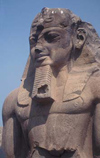Who Struck Down Pharaoh's Firstborn Son?
An archeological discovery challenges the biblical story of the tenth plague, in which a cruel ruler's son was killed by God.
BY: Interview with Charles Sennott

Can new archeological discoveries prove--or disprove--parts of the Bible? Egyptologist Kent Weeks recently found a man's skull in a tomb believed to be that of Rameses II's oldest son, who the book of Exodus says died in the tenth plague. Beliefnet spoke with author and Boston Globe correspondent Charles M. Sennott, who worked with the Discovery Channel on a program showcasing the finding, about how the news impacts our understanding of the exodus.
Rameses: Wrath of God or Man? aired on the Discovery Channel on Sunday December 5.
Who was Rameses II in history, and who is he thought to be in the Bible?
Most historians believe that Rameses II is the pharaoh of the Exodus, in the story with the ten plagues--the one whose oldest son, the crown prince, was killed in the tenth plague. There's no way to know for sure if indeed Rameses II
was that pharaoh, but it's the consensus between historians and Egyptologists.
Rameses was the greatest pharaoh, the master builder. He built more monuments than any other pharaoh. He had over 100 children by [many] wives. He had a tremendous ego. If you see the sites of ancient Egypt, you see his image everywhere, because he believed he was a living God.
From what we know from nonbiblical sources and from archeology, was Rameses II the kind of ruler who would have been stiff-necked, who would have oppressed slaves?
Yes, the Egyptian pharaohs ruled with a serious iron fist over a vast swath of very poor people. They did this through their court, military, and the exertion of completely autocratic power. Rameses was the archetype of the master builder who required serious slave labor.
What is the new discovery related to this pharaoh?
We traveled with Kent Weeks, a world-renowned Egyptologist. I studied his work at KV5, one of the most important archeological finds since King Tut. It's essentially a vast burial ground [in the Valley of the Kings near Luxor], a serious of corridors and chambers that Weeks says holds more than 120 burial chambers, all of them dedicated, Weeks believes, to the sons of Rameses II.
Weeks discovered this in 1995. He then spent the next years digging through there [see
map]. There are relief murals that clearly show Rameses II guiding his oldest son, the crown prince Amun-her-khepeshef, into the afterlife.
Weeks' strong belief is that this is where the oldest son of the presumed pharaoh of the Exodus is buried.
But Rameses II himself was not yet dead?Yes, but as a god, Rameses would have been the one to guide him to the other gods.
Even though Rameses II, the father, was still alive, he could lead his dead son to the afterlife?Yes. He could lead him to the point where he was given over to the gods.
So the belief is that Rameses' oldest son was a military leader, because we see him depicted in relief sculpture as a man in a chariot riding off to battle. So the question is, is he buried there? Weeks found 4 skulls very close to the entry to this KV5 tomb. Weeks believes that one of these skulls, with a large fracture on the left-hand side at the rear of the skull, may indeed be the skull of Amun-her-khepeshef.
No comments:
Post a Comment